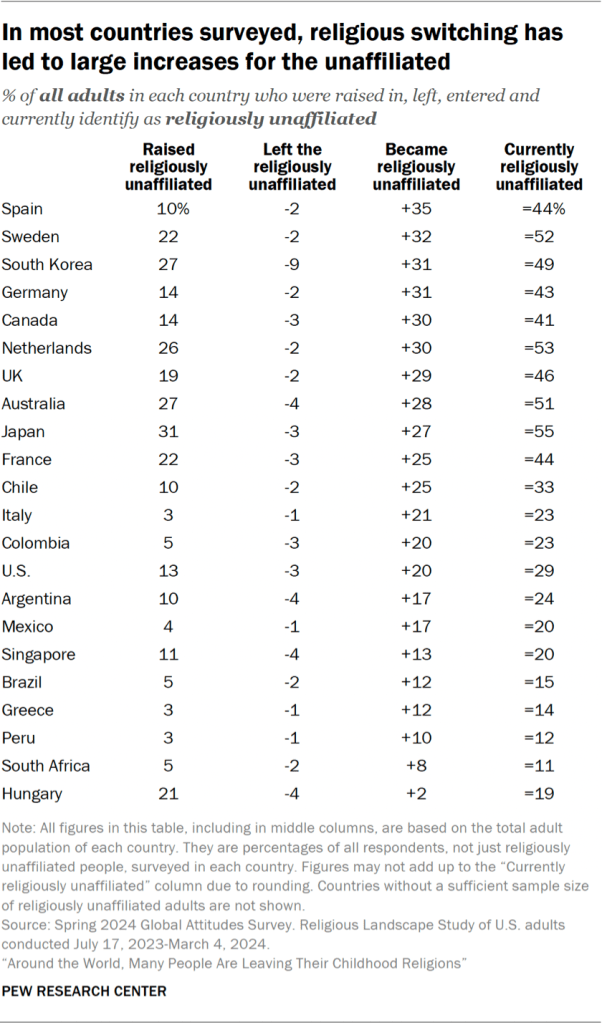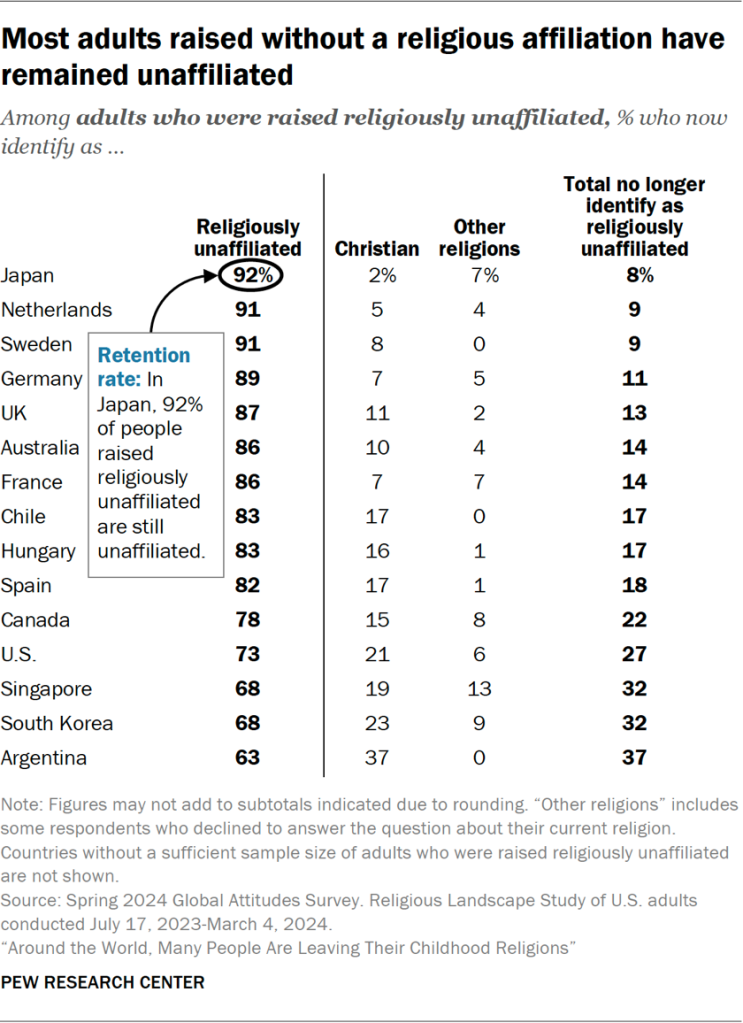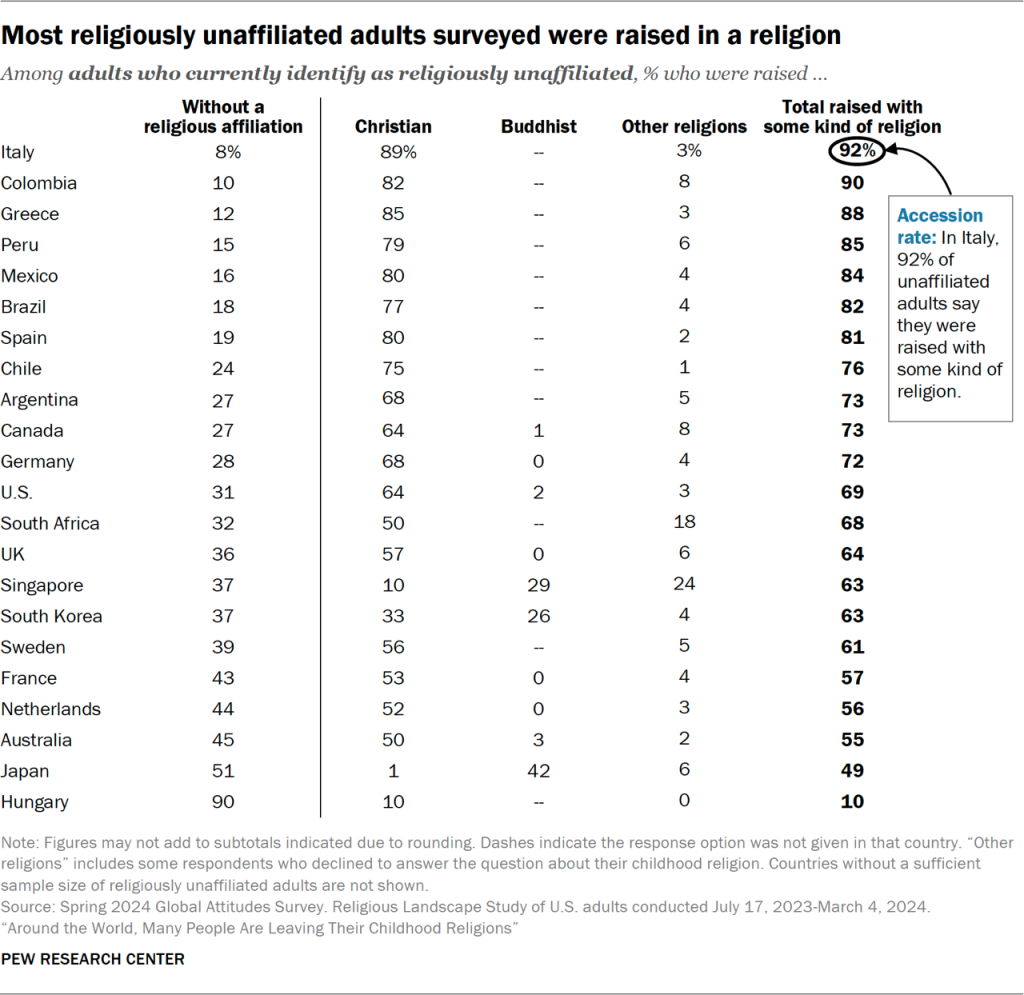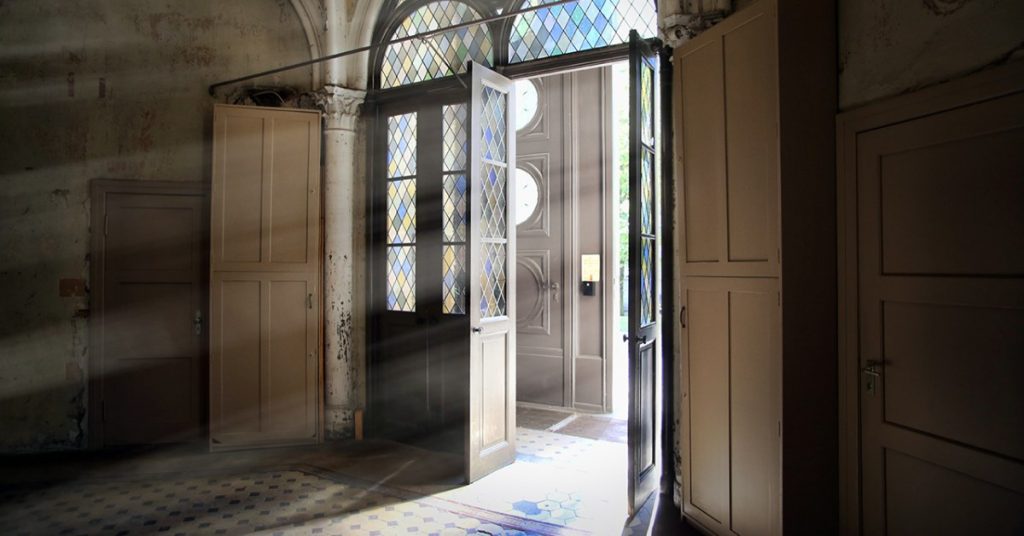Terminology
Throughout this report, religious switching refers to a change between the religious group in which a person says they were raised (during their childhood) and their religious identity now (in adulthood). The rates of religious switching are based on responses to two survey questions we asked of adults ages 18 and older:
- “What is your current religion, if any?”
- “Thinking about when you were a child, in what religion were you raised, if any?”
The responses to these two questions allow us to calculate what percentage of the public has left a religious group (or “switched out”) and what percentage has entered (or “switched in”). This kind of switching can take place without any formal rite or ceremony.
We have analyzed switching into and out of five widely recognized, worldwide religions to allow for consistent comparisons around the globe. Specifically, this report analyzes change between the following groups: Christianity, Islam, Judaism, Buddhism, Hinduism, other religions, religiously unaffiliated adults, and those who did not answer the question.
For example, someone who was raised Buddhist but now identifies as Christian would be considered as having switched religions – as would someone who was raised Christian but is now unaffiliated.
However, switching within a religious tradition, such as between Catholicism and Protestantism, is not captured in this report. (Refer to Pew Research Center’s 2023-24 Religious Landscape Study for an analysis of switching in the United States that does count some switching within Christianity. Read “4 facts about religious switching within Judaism in Israel” for an analysis of switching within Judaism.)
Religiously unaffiliated refers to people who answer a question about their current religion (or their upbringing) by saying they are (or were raised as) atheist, agnostic or “nothing in particular.” This category is sometimes called “no religion” or “nones.”
Other religions is an umbrella category. It contains a wide variety of religions that are not in the other categories and that have survey sample sizes too small to analyze separately in most countries. This includes Sikhism, Jainism, the Baha’i faith, African traditional religions, Native American religious traditions, and others.
Disaffiliation rates refer to the percentage of adults who say they were raised in a religion but are now religiously unaffiliated (or have no religion).
Net gains/losses are the differences between the percentage of survey respondents who say they were raised in a particular religious category (as children) and the percentage who identify with that same category at the time of the survey (as adults). The “net” gain or loss takes into account both sides of the equation – those who have left and those who have entered the group.
Retention rates show, among all the people who say they were raised in a particular religious group, the percentage who still describe themselves as belonging to that group today.
Accession rates (also called entrance rates) show, among all the people who describe themselves as belonging to a particular religious group today, the percentage who were raised in some other group.
This section takes a closer look at religious switching into and out of the religiously unaffiliated category, which consists of people who describe their religion as atheist, agnostic or “nothing in particular.” This group is sometimes referred to as religious “nones.”
Read on for details about where the religiously unaffiliated population has had the largest net gains, what percentage of people raised without a religion are still unaffiliated (i.e., retention rates), which religious groups those who have left the unaffiliated have switched into, and where the religiously unaffiliated population has the largest shares of new entrants (i.e., the highest accession rates).
Of the 36 countries surveyed, 22 have sufficient sample sizes of “nones” to allow analysis of religious switching into and out of the religiously unaffiliated group.
Net gains for the religiously unaffiliated
- In almost every country analyzed, more people have entered the religiously unaffiliated category than have left it.
- Spain has had the largest net gains for the religiously unaffiliated from religious switching.
Remaining religiously unaffiliated
- In many countries, the majority of adults who were raised without a religion are still unaffiliated as adults. This ranges from 63% in Argentina to 92% in Japan.
Leaving the religiously unaffiliated
- In the countries with the largest shares of people leaving the unaffiliated – such as in Argentina – these losses are largely due to people switching to Christianity.
- Some places, such as Singapore, also have seen a small percentage of unaffiliated people switching to Buddhism or Islam.
Entering the religiously unaffiliated
- Italy, Colombia and Greece have the highest levels of “accession,” or entrance, into their religiously unaffiliated populations, with roughly nine-in-ten unaffiliated adults in these countries saying they were raised in a religious tradition. Currently, 23% of Italian and Colombian adults, along with 14% of Greeks, identify as unaffiliated.
- Among those who have switched to become religiously unaffiliated, many were raised Christian.
Where have the religiously unaffiliated experienced the largest net gains from religious switching?
In over half the countries surveyed, more adults say they were raised with a religious affiliation and are now unaffiliated than say they were raised unaffiliated but have since joined a religion. To put it another way, the unaffiliated population has experienced net gains from religious switching.

In Sweden, for example, 52% of adults currently identify as religiously unaffiliated, while just 22% say they were raised without a religion – a difference of 30 percentage points. It results from 32% of all Swedish adults saying they have left their childhood religion and now identify as “nones,” while just 2% of Swedish adults have moved in the opposite direction – from having no religion as children to identifying with a religion as adults.
Even though South Korea has the largest share of adults who have left the ranks of the religiously unaffiliated and taken on a religion (9%), there are far more Koreans who say they were raised in a religion and have since disaffiliated (31%), yielding a 22% net gain for the unaffiliated population among all South Korean adults.
What percentage of people raised without a religion are still unaffiliated?
In many countries, a sizable majority of adults who say they were raised without a religion remain unaffiliated today, yielding a high retention rate for the unaffiliated population.

Japan, the Netherlands and Sweden have the highest retention rates among the unaffiliated. In each country, at least nine-in-ten adults who were raised religiously unaffiliated still do not identify with a religion.
The lowest retention rates among the religiously unaffiliated are in Singapore, South Korea and Argentina – where about a third or more of people raised without a religion say they now identify with a religion.
Which religious groups have formerly unaffiliated people switched to?
Analyzing retention rates also reveals which religions have been adopted by people who were raised as religiously unaffiliated. In general, among people brought up without a religion who now identify with one, Christianity is the most common choice.
(Read more about entrance rates into Christianity in Chapter 1.)
In a few of the surveyed countries, relatively small shares of people who grew up religiously unaffiliated now identify as Buddhists or Muslims. For example, 6% of Singaporeans who were raised unaffiliated now describe themselves as Buddhists.
Where do the religiously unaffiliated have the largest shares of new entrants?
Most religiously unaffiliated adults surveyed were raised in some religious tradition as children.
In Italy, Colombia and Greece, roughly nine-in-ten adults who now have no religion say they were brought up with some religious affiliation, meaning that the religiously unaffiliated population in those places has a very high “accession” (or entrance) rate.
In these three countries, as well as many others in Europe and the Americas, a large share of religiously unaffiliated adults were raised Christian.

But in Japan, Singapore and South Korea, large shares of today’s religiously unaffiliated population also were raised in religions besides Christianity.
For example, in South Korea, 37% of unaffiliated adults were raised as “nones,” while 33% were raised Christian and 26% were raised Buddhist. In Singapore, nearly a quarter of unaffiliated adults were raised in some religion outside of Christianity or Buddhism, including 17% who say they were raised in a traditional Chinese religion.
Hungary is the only country surveyed in which fewer than around half of all unaffiliated adults were raised with some sort of religion. Unlike its European neighbors, in Hungary only 10% of unaffiliated adults were raised as Christians. This may reflect the legacy of Hungary’s communist period, which lasted from 1949 until 1989.








